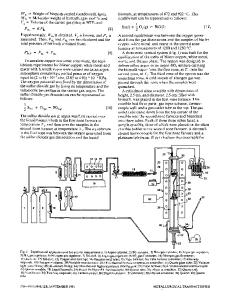Thermodynamic modeling of selenide matte converting
- PDF / 387,700 Bytes
- 9 Pages / 612 x 792 pts (letter) Page_size
- 3 Downloads / 355 Views
I.
INTRODUCTION
ANODE slimes are a by-product of the electrolytic refining of copper anodes. They originate from impurities in the copper and are a mixture of elements and compounds present in the anodes or formed during or after anodic dissolution through reactions of the species with each other and with the electrolyte. Anode slimes are a valuable resource, containing significant amounts of silver, gold, the platinum group metals, and selenium. The composition of slimes is very variable, since it depends on the minor-element content of the original sulfide orebody from which the copper was smelted. Slimes typically contain from 5 to 53 pct copper, 5 to 20 pct silver, up to 1 pct gold, 1 to 45 pct selenium, and 2 to 30 pct lead, as well as small amounts of tellurium, sulfur, arsenic, bismuth, antimony, and nickel. The mineralogy of anode slimes is complex, and about 100 species have been identified.[1–5] While the mineralogy is highly variable from one slime to another, some generalizations are possible. Silver is found partly in the metallic state, but is mainly associated with selenium as silver selenide (Ag2Se) and silver copper selenide (AgCuSe); copper is present in the metallic state, as the sulfate or the oxide and associated with selenium as copper selenide (Cu2Se) and AgCuSe; lead is present mainly as lead sulfate (PbSO4). The processing of slimes involves many steps; however, the primary aim is to remove copper, selenium, tellurium, etc., and to leave silver, gold, and the platinum group metals, as an alloy called ‘‘dore´.’’ The pyrometallurgical method of processing usually involves pretreating the slimes by either leaching with sulfuric acid (tankhouse electrolyte), or, less commonly, roasting with concentrated sulD.R. SWINBOURNE, Discipline Leader, Metallurgical Engineering, is with the Department of Chemical and Metallurgical Engineering, Royal Melbourne Institute of Technology, Melbourne 3001, Australia. A. YAZAWA, Emeritus Professor, is with Tohoku University, Sendai 980, Japan. G.G. BARBANTE, formerly Postgraduate Student with the Department of Chemical and Metallurgical Engineering, Royal Melbourne Institute of Technology, is Process Engineer with Ausmelt Ltd., South Dandenong 3164, Australia. Manuscript submitted September 19, 1996. METALLURGICAL AND MATERIALS TRANSACTIONS B
furic acid at 600 7C. Leaching removes much of the copper that is in the form of the metal, oxide, or sulfate, but little that is in the form of Cu2Se.[6] Pretreated slimes are smelted in a small reverberatory furnace, or in more intense reactors such as top-blown rotary converters,[7] bottom-blown oxygen converters,[8] or Sirosmelt reactors[9] to produce dore´ metal (an alloy containing 98 to 99 pct Ag). These are all batch processes that involve melting of the slimes, additions of fluxes such as sodium carbonate and silica or borax, injection of air or oxygen into the molten bath, numerous skimmings of the slag, and fresh additions of fluxes and oxidizing agents such as sodium nitrate. Large quantities of silver-rich sl
Data Loading...











